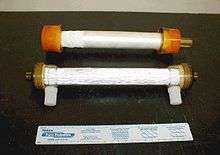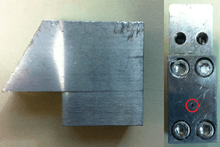Hollow fiber membrane
Hollow fiber membranes (HFMs) are a class of artificial membranes containing a semi-permeable barrier in the form of a hollow fiber. Originally developed in the 1960s for reverse osmosis applications, hollow fiber membranes have since become prevalent in water treatment, desalination, cell culture, medicine, and tissue engineering.[1] Most commercial hollow fiber membranes are packed into cartridges which can be used for a variety of liquid and gaseous separations.

Manufacturing
HFMs are commonly produced using artificial polymers. The specific production methods involved are heavily dependent on the type of polymer used as well as its molecular weight. HFM production, commonly referred to as "spinning," can be divided into four general types:
- Melt Spinning, in which a thermoplastic polymer is melted and extruded through a spinneret into air and subsequently cooled.[2]
- Dry Spinning, in which a polymer is dissolved in an appropriate solvent and extruded through a spinneret into air.[3]
- Dry-Jet Wet Spinning, in which a polymer is dissolved in an appropriate solvent and extruded into air and a subsequent coagulant (usually water).[3]
- Wet spinning, in which a polymer is dissolved and extruded directly into a coagulant (usually water).[3]
Common to each of these methods is the use of a spinneret, a device containing a needle through which solvent is extruded and an annulus through which a polymer solution is extruded. As the polymer is extruded through the annulus of the spinneret, it retains a hollow cylindrical shape. As the polymer exits the spinneret, it solidifies into a membrane through a process known as phase inversion. The properties of the membrane -such as average pore diameter and membrane thickness- can be finely tuned by changing the dimensions of the spinneret, temperature and composition of "dope" (polymer) and "bore" (solvent) solutions, length of air gap (for dry-jet wet spinning), temperature and composition of the coagulant, as well as the speed at which produced fiber is collected by a motorized spool. Extrusion of the polymer and solvent through the spinneret can be accomplished either through the use of gas-extrusion or a metered pump. Some of the polymers most commonly used for fabricating HFMs include cellulose acetate, polysulfone, polyethersulfone, and polyvinylidene fluoride.[4]

Characterization
The properties of HFMs can be characterized using the same techniques commonly used for other types of membranes. The primary properties of interest for HFMs are average pore diameter and pore distribution, measurable via a technique known as porosimetry, a feature of several laboratory instruments used for measuring pore size.[5] Pore diameter can also be measured via a technique known as evapoporometry, in which evaporation of 2-propanol through the pores of a membrane is related to pore-size via the Kelvin equation.[6][7] Depending on the diameters of pores in an HFM, scanning electron microscopy or transmission electron microscopy can be used to yield a qualitative perspective of pore size.
See also
References
- ↑ Encyclopedia of Life Support Systems (Eolss): v.1 : Desalination and Water Resources (Desware): Membrane Processes. Oxford: EOLSS Publishers Co Ltd. 2010. ISBN 978-1-84826-877-7.
- ↑ Imsail, Ahmad; Khulbe, Kailash; Matsuura, Takeshi (Apr 28, 2015). Gas Separation Membranes: Polymeric and Inorganic. Springer. ISBN 9783319010953.
- 1 2 3 Wang, Lawrence; Chen, Jiaping; Hung, Yung-Tse; Shammas, Nazih. Membrane and Desalination Technologies. Springer Science & Business Media. ISBN 9781597452786.
- ↑ Feng, C.Y.; Khulbe, K.C.; Matsuura, T.; Ismail, A.F. (June 2013). "Recent progresses in polymeric hollow fiber membrane preparation, characterization and applications". Separation and Purification Technology. 111: 43–71. doi:10.1016/j.seppur.2013.03.017.
- ↑ A.B. Abell, K.L. Willis and D.A. Lange, "Mercury Intrusion Porosimetry and Image Analysis of Cement-Based Materials", Journal of Colloid and Interface Science, 211, pp. 39-44 (1999).
- ↑ Krantz, William B.; Greenberg, Alan R.; Kujundzic, Elmira; Yeo, Adrian; Hosseini, Seyed S. (July 2013). "Evapoporometry: A novel technique for determining the pore-size distribution of membranes". Journal of Membrane Science. 438: 153–166. doi:10.1016/j.memsci.2013.03.045.
- ↑ Merriman, Lauren; Moix, Alex; Beitle, Robert; Hestekin, Jamie (October 2014). "Carbon dioxide gas delivery to thin-film aqueous systems via hollow fiber membranes". Chemical Engineering Journal. 253: 165–173. doi:10.1016/j.cej.2014.04.075.